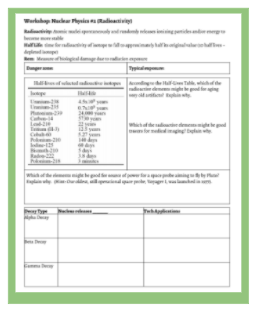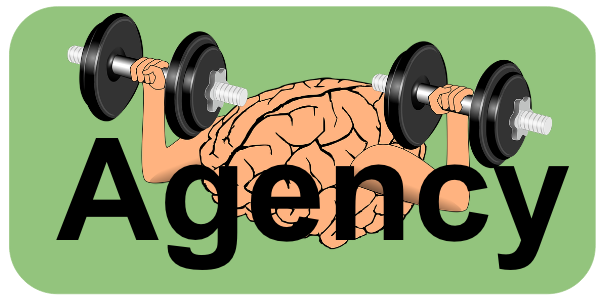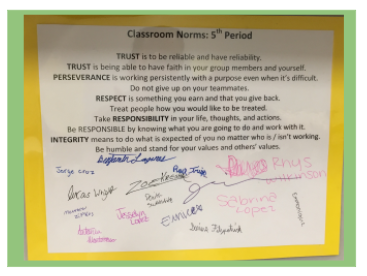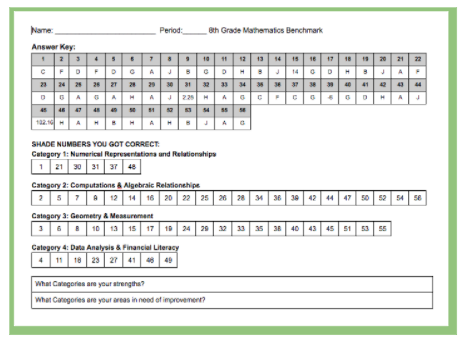Agency is developing a growth mindset over time and taking ownership of one’s learning. Systems that scaffold agency promote:
- Growth Mindset Culture
- Student Generated Next Steps
- Growth of Students’ Self Knowledge and Related Strategies
- Development of Students’ Organization Skills over Time
Growth Mindset Culture
Growth Mindset Activities
It it worthwhile to spend the first week of school doing activities that jumpstart a growth mindset culture. To see specific activities relating to mathematics that promote growth mindset, visit the Week of Inspirational Math activities. Also, you can check out this related blog article.
Norm Building Activities
One worthwhile first week activity is to have students work together to brainstorm and refine classroom norms that promote growth mindset. In the CINGHS Algebra 2 and Integrated Physics & Engineering classes, the students generated norms that focused on the school’s Core Values: integrity, responsibility, perseverance, trust and respect. To see a sample set of norms, check out the linked image below:
Norms in Team Contracts
Throughout the year, Dr. Trinidad has students reflect on the norms by selecting 3 norms each project to unpack and focus on in their team contracts.
Student Generated Next Steps
Next Steps Prompts
Students who take ownership of their own learning know how to generate, enact and track next steps and they know how to request help from teachers as needed. Teachers can cultivate these skills by designing prompts that ask students to:
- Request workshops related to Need-to-Knows
- Plan next steps related to project feedback
- Plan next steps related to making up late work or revising project work.
Zap Chart
The following ZAP (Zeroes Aren’t Possible) chart was used by students to analyze what assignments they needed to improve in order to bring up their grades. The chart also helped them to set-up a plan to make up that work over the course of one school week.
Growth of Students’ Self Knowledge and Related Strategies
Learning Style Inventory Quizzes
Early in the school year, students taking math classes at CINGHS take a learning style inventory quiz to identify their top learning styles. Then they research strategies that go with their top learning styles. The quiz results and the suggested strategies are stored in the front of their interactive math notebooks.
Agency Self-Assessments & Reflections
Students can use Agency rubrics to reflect on their strengths and challenges in regard to agency. They can submit their agency scores via Google form to a teacher who can use the data to identify class-wide strengths and gaps. The teachers can use this analysis to design activities that help students overcome their agency challenges. These activities can encourage students to:
- reflect on the things they may gain by trying new things in their agency gaps
- brainstorm and research strategies that can help them overcome agency gaps
- set and meet agency goals that counteract agency gaps
Heat Maps
After benchmarks, students complete Heat Maps (see linked example below). Students color in boxes that correspond to correct responses on the benchmarks. The boxes are arranged into categories that enable students to see patterns that show their academic strengths and their gaps. Students can use this knowledge to request workshops and activities that help them overcome their gaps.
3 Color Practice Tests
Prior to taking tests, students in Dr. Trinidad’s math and physics classes take a 3 Color practice test. They take the practice test under test conditions (independently and silently) using their first color. Then, they change colors and use their notebooks to add responses and corrections to their answer sheet. Then, they use the final color to correct their practice test work using a test key. The colors applied to each problem help students to understand what types of problems they need to study (or not) while preparing for upcoming tests.
Access to Practice Set Keys
Students in Dr. Trinidad’s math and science classes are assigned practice sets that are always due at the end of school weeks. When students finish practice sets early, they can request practice set keys and use a second color to correct their work. Dr. Trinidad grades this corrected work as if it’s perfect work because she values the lessons students learn when they compare their work to model work.
Development of Students’ Organization Skills over Time
Notebook Organization
Students taking science and math at CINGHS maintain detailed interactive notebooks. To help students access the information in their notebooks, teachers regularly teach students how to update notebook tables of contents that show where all notebook resources are located in the notebooks.
Project Google Folders
Students also learn how to organize electronic versions of their student work by following course standards for maintaining Google folders. In Algebra 2 and Integrated Physics and Engineering, students are required to have course folders that contain sub-folders that are dedicated to each project in the courses.
Graphic Organizers
To further help students organize their student work, teacher ofen design graphic organizers that help students organize the their workshop notes and their research. See linked examples:
 |
 |
 |





